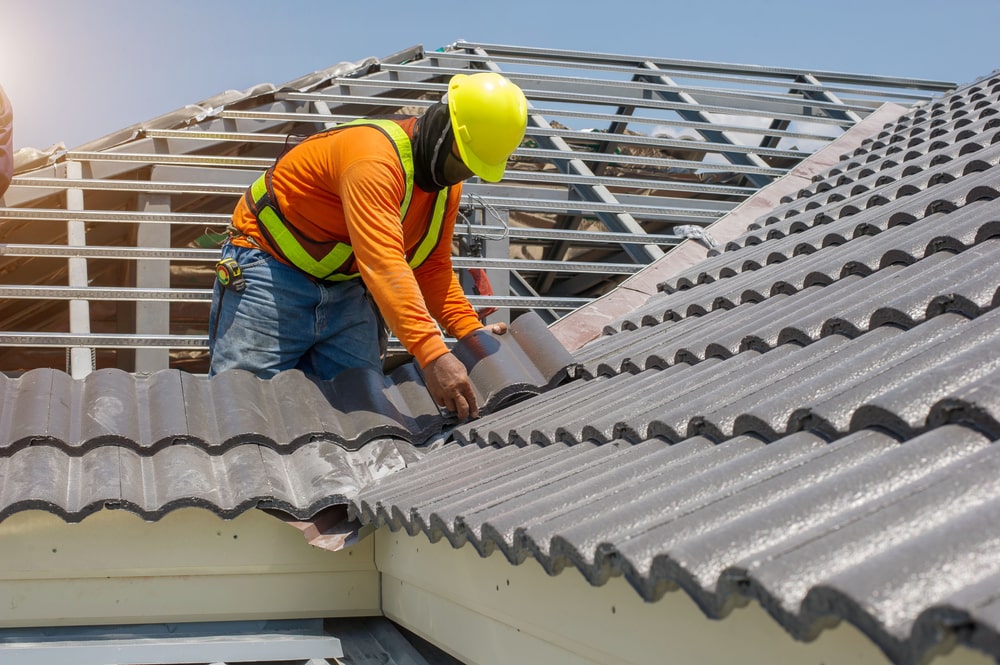A Comprehensive Consider Roofing Companies Gainesville Residents Recommend
A Comprehensive Consider Roofing Companies Gainesville Residents Recommend
Blog Article
Best Practices for Ensuring Correct Roofing Air Flow
Guaranteeing correct roof covering ventilation is critical for the longevity and effectiveness of a roof system. A well balanced consumption and exhaust air vent ratio, frequently 1:300, plays an essential role, with consumption vents ideally positioned at the reduced side of the roofing system for great air entry and exhaust vents at the optimal for warm air exit. Normal inspections to identify clogs and keep clear air flow are extremely important. Keeping insulation away from vents is critical to prevent air flow restriction. Recognizing these fundamental components sets the phase for more thorough understandings right into installation and upkeep techniques that can dramatically improve your roof's performance.
Understand Ventilation Essentials
Correctly comprehending air flow fundamentals is necessary for making certain the long life and effectiveness of roof. Reliable ventilation mitigates moisture build-up and temperature level extremes in the attic, both of which can cause substantial architectural damages in time. A well-ventilated roof covering aids in stopping usual concerns such as mold growth, timber rot, and ice dams, which can compromise the stability of the roof products and the underlying frameworks.
The primary goal of air flow is to assist in the motion of air, enabling for a regular exchange in between the interior and outdoor environments. This balance is accomplished through a combination of intake and exhaust vents that collaborate to preserve optimum air flow. Intake vents, usually situated along the eaves or soffits, allow fresh air to enter the attic room, while exhaust vents, commonly positioned at or near the roof ridge, enable warm, damp air to leave.
Key factors affecting the effectiveness of roofing system air flow consist of correct placement, sufficient sizing, and making sure that both consumption and exhaust vents are unhampered. Regular inspection and upkeep are vital to determine potential blockages, damage, or ineffectiveness in the air flow system, therefore guarding the roofing's performance and durability.
Kinds Of Roof Vents
Roofing vents play a crucial duty in maintaining effective attic room air flow and, by expansion, the overall wellness of the roofing system. Numerous types of roof covering vents are readily available, each with unique advantages tailored to specific roof requirements.

Soffit vents are mounted under the eaves and operate in tandem with roofing vents to make sure a well balanced consumption and exhaust system. By allowing cooler air to get in from below, soffit vents promote the expulsion of hot air via top vents. Gable vents, located on the outside walls of the attic, offer an additional effective service, particularly in homes with saddleback roofs.
Examine Your Current Air Flow

Next, take into consideration the age and problem of your roof covering materials and ventilation parts. Older systems might not follow present structure codes or might have deteriorated over time, lowering their performance. Conduct a detailed evaluation to recognize any kind of indicators of deterioration, such as corrosion, damages, or voids that could jeopardize the system's performance.
In addition, determine the attic temperature and moisture levels. Heats and humidity can suggest poor ventilation - roofing companies. Utilize a hygrometer and thermostat to acquire accurate readings, contrasting them with outside conditions. Relentless disparities recommend possible concerns that need dealing with.
Installation Best Practices
Effective installation of roof ventilation systems is extremely important for ensuring ideal performance and durability. Appropriate installment begins with understanding the details ventilation needs of the building and the roofing system it covers. This includes calculating the proper ratio of intake to tire vents, normally sticking to the 1:300 policy, which stipulates one square foot of air flow for each 300 square feet of attic room flooring room.

Consumption vents ought to be installed at the roofing's lower edge, often in the soffits, to allow trendy air to get in. Exhaust vents, on the other hand, need to be installed near or at the roofing system's top to promote the exit of cozy, damp air.
Seal all air vent links meticulously to stop air leakages and prospective water seepage. Use premium materials and comply with supplier guidelines to make certain longevity and efficiency. In addition, incorporating ridge vents with baffles can dramatically enhance airflow performance by protecting against wind-driven rain and snow from getting in the attic.
Eventually, specific installation of roof air flow systems reduces possible concerns such as mold and mildew growth, ice dams, and architectural damage, making certain the roofing's honesty and the structure's total health.
Regular Maintenance Tips
Consistency in maintenance practices is basic to ensuring the long-lasting effectiveness of roofing air flow systems. Normal evaluations are important, try these out preferably done biannually-- in the springtime and loss. Throughout these evaluations, ensure that vents are devoid of particles, nests, and various other blockages that could hamper air movement. Look for any kind of signs of dampness build-up or mold, as these can suggest improper ventilation or leakages (roofing companies).
Make use of a soft brush or a vacuum cleaner to eliminate dirt and particles from intake and exhaust vents. Be careful not to damage the vent displays or louvers throughout the procedure.
Proper insulation is similarly crucial. Make sure that attic room insulation does not obstruct the vents, as this can seriously restrict air movement. If any kind of insulation has moved or resolved, reposition or replace it to maintain an effective barrier.
Finally, replace any type of damaged or missing parts promptly. Damaged vents, fractured shingles, or deteriorated blinking can all add to inadequate ventilation and should be attended to without delay. Regular upkeep ensures that the roofing air flow system works efficiently, thus expanding the life-span of the roof itself.
Verdict
Ensuring appropriate roof covering ventilation is critical for preserving the effectiveness and longevity of a roofing system. Adherence to the 1:300 intake and exhaust vent ratio, paired with the critical placement of vents, is essential.
A balanced intake and exhaust vent proportion, frequently 1:300, plays a pivotal role, with consumption vents ideally placed at the reduced edge of the roofing for awesome air access and exhaust vents at the optimal for cozy air departure. Intake vents, normally located along the eaves or soffits, enable fresh air to enter the attic room area, while exhaust vents, usually positioned at or near the roofing ridge, make it possible for hot, humid air to escape.
Soffit vents are set up under the eaves and work in tandem with roofing vents to ensure a balanced intake and exhaust system. By enabling cooler air to go into from below, soffit vents facilitate the expulsion of hot air with upper vents. Adherence to the 1:300 intake and exhaust air vent proportion, coupled with the calculated placement of vents, is crucial.
Report this page